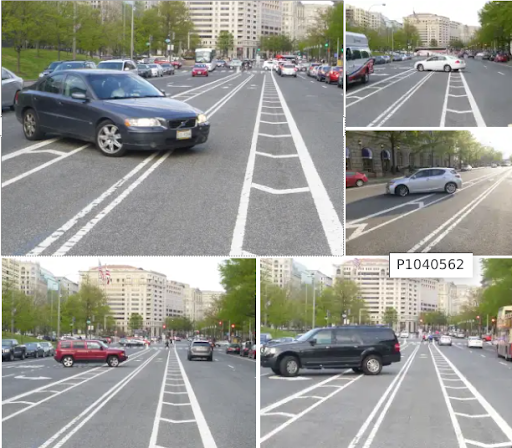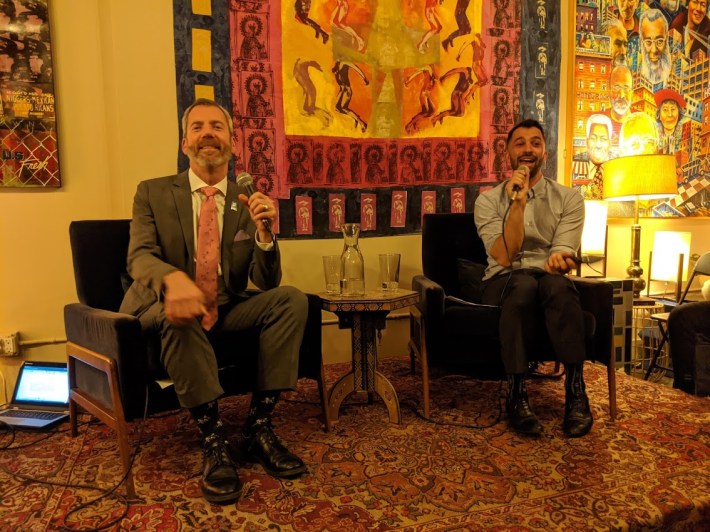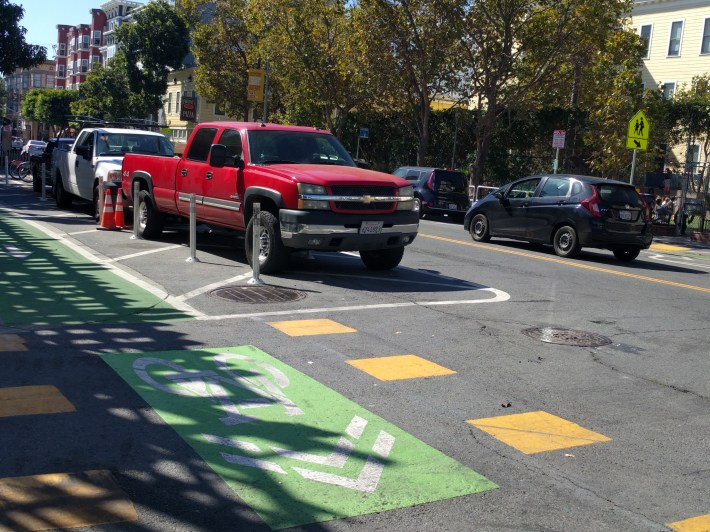Note: GJEL Accident Attorneys regularly sponsors coverage on Streetsblog San Francisco and Streetsblog California. Unless noted in the story, GJEL Accident Attorneys is not consulted for the content or editorial direction of the sponsored content.
The SFMTA Board, at its regular meeting on Tuesday, voted unanimously to continue planning for the removal and replacement of the Valencia center-running bike lane with Dutch-style curbside protected lanes (a final decision will be made in the summer when plans are complete). In fact, SFMTA has already been meeting with merchants about how to move and reconfigure parklets to accommodate curbside lanes. Despite that, the agency has committed to completing the 12-month, center-running pilot.
Given the misinformation circulating around these developments, it's time to correct and clarify a few things with the ongoing Valencia center-running pilot enterprise.
1) Despite SFMTA's public claims, data shows the Valencia center-running bike lane has so far increased the number of crashes

Just before the President's Day Weekend, SFMTA finally released its months-overdue 42-page evaluation of the center-running pilot. The report's authors went to great lengths to boast about fewer double-parked cars and a reduction in dooring and sideswipe collisions in the middle part of the blocks.
"We provided safe spaces for cyclists, and we significantly reduced the types of collisions that we had been seeing pre-COVID [emphasis added],” SFMTA's Jeffrey Tumlin told KQED, during a media roundtable Thursday.
But the spin belies the fact that the lane caused significantly more collisions overall, presumably because of the increased danger at intersections. On request, SFMTA sent the following data to Streetsblog comparing the number of collisions before and after the installation:

There were also four collisions involving a pedestrian in the same period. There was only one over the same period in 2022.
SFMTA officials pointed out that the section of protected bike lanes between Market and 15th, which has traditional, curbside-protected lanes, also saw a spike in collisions during the six-month "adjustment period" when they first opened in 2019 (more on that below). It later came down sharply below pre-installation levels and stayed down.
Of course, these are small datasets. And perhaps the center-running lane will correct and eventually show itself safer than the street was before its installation as well. However, the danger at intersections, including the crash that killed Jian Huang, is so far mapping on experiences with the center-running bike lane on Pennsylvania Avenue in Washington D.C. (see image above, and note that D.C. is now planning to rip its center-running lane on Pennsylvania Avenue out because of its failings).
And yet SFMTA's blog post about the three-month study of the center-running lanes says "Valencia Bike Pilot Reduces Bike-Car Conflicts" in the title.
2) Meanwhile, the Valencia Corridor Merchants Association (VCMA) demands the removal of the center-running lane

In a letter delivered on Monday to the SFMTA, the VCMA made it clear they want the center-running lane removed as soon as possible. It also seems clear that they are amenable to curbside protected bike lanes (at least over the existing configuration) but that they have concerns about the parklet configuration and the removal of adjacent parking. From the letter, which focuses on the perceived damage to the entire corridor's vibrancy and the bottom line of merchants:
This needs to be addressed by quickly removing the center-running bike lane and installing an alternative that maintains safety for everyone and won’t kill business. We understand that a side-running bike lane is being considered and we have concerns that we’d need the City to allay for this design. In addition to the fear of conflict between customers, services, vendors, and bikes, we are nervous about the tremendous loss of customer parking that a side-running bike lane might create. There are many things that the SFMTA could do to implement an improved side running design and we ask that all of these measures be taken.
This is in addition to a different merchant group that held a protest in the center-running bike lane and is now threatening to sue SFMTA to get it removed.
The absurd irony here: the center-running design was primarily intended to appease merchants and their concerns about the loss of parking.
Another level of irony: Manny Yekutiel, president of the VCMA pictured above, recently resigned from the SFMTA board. He voted for the center-running lane last April, albeit it was the only option presented by SFMTA's Tumlin. At the time, Tumlin told Yekutiel and the rest of the board that curbside-protected lanes were impossible because of "fatal flaws."
3) An important clarification on the other "quick build" pilot: the one between Market and 15th

Returning to Tuesday's SFMTA meeting, four people spoke to offer various degrees of praise for the center-running lane (which runs on Valencia between 15th and 23rd). Support for the center-running bike lane, both according to SFMTA studies and a new survey of San Francisco Bicycle Coalition members, has always been and continues to be a small minority. Meanwhile, the Better Valencia campaign has over 1,300 signatures supporting the abandonment of the center-running lanes. And "SFBC is [now] calling on staff to develop a plan for curbside, parking-protected bike lanes," said Christopher White, the San Francisco Bicycle Coalition's interim director, during the same SFMTA meeting, specifying that he nevertheless wants the center-running pilot completed. "Let’s finish out this pilot and learn everything we can and let’s also be ready to pivot."
Nevertheless, bikes-on-Caltrain-advocate and former SFBC Board Member Shirley Johnson told the SFMTA at the same meeting that she strongly prefers the center-running section to the earlier, Dutch-style parking-protected bike lanes (between Market and 15th), because on the protected section "motorists don’t see me when I’m behind parked cars, pedestrians step right into the bike lane ... When I get to that center running bike lane my stress level drops a couple of notches."
It's easy to forget that the protected section between Market and 15th, installed in 2019, is also a "quick build" (it was done with inexpensive, temporary materials that were to be replaced with concrete, but never were except in front of the two schools on the street). When Johnson complains that motorists can't see her, it's because the areas around driveways and intersections are supposed to be no-parking zones (aka: "daylighted") to maintain sight-lines. Unfortunately, they are routinely parked on because SFMTA used plastic posts or just paint instead of concrete or another sufficiently hefty material to keep those essential areas clear of cars (see image above of a truck parked on top of the plastic posts, blocking the view of the lane at the intersection). The intersections are also unprotected, employing a mixing-zone design that Streetsblog has long criticized. The protection also drops off mid-block where the lane goes around the Four Barrel parklet, the U-Haul dealer, a hotel parking lot, and a few other spots.
Nevertheless, the partially protected bike lanes from 15th to Market still have a superior record on safety, because they're based on a fundamentally safer design. It's just important to keep in mind that they are also deficient for the simple reason that they were never actually finished and still suffer from SFMTA's subpar, compromised, and sloppy "quick build" execution. And that's a quick build that has now been in place for five years.
As Tumlin himself recommended during the meeting, people need to watch Streetfilms, such as this one that highlights why protected bike lanes are safer for pedestrians. Or head over to Oakland, Fremont, or Alameda to see what properly protected bike lanes and protected intersections are supposed to look like.






